Oxford University Press's Blog, page 337
August 11, 2017
From singer to choir director: A Q&A with Ben Parry
Ben Parry studied at Cambridge University, where he was a member of The Choir of King’s College, Cambridge, before he became the musical director of, and singer with, the Swingle Singers. Today, Ben has a busy career as a conductor, arranger, singer and producer in both classical and light music fields; directing choirs as varied as the National Youth Choirs of Great Britain and the professional choir London Voices, to the King’s College Cambridge mixed choir – King’s voices, and Aldeburgh voices. We caught up with Ben to ask him about his progression from singer to director, his conducting experiences, and his advice for directors wishing to set up their own choirs.
With the amount of conducting work you do, you must have to move around a lot! Could you tell us what a typical week in your life looks like?
Any week can be crazy but very rewarding! A typical week might include a choral evensong in King’s (as director of King’s Voices), a film session at Abbey Road or Air Studios with my professional choir – London Voices, a meeting for National Youth Choirs of Great Britain, a rehearsal at Snape Maltings with Aldeburgh Voices, and, sometimes, composing or arranging choral music at home.
Although you started out as a singer, much of your work now revolves around directing. How did you make the progression from singer to director?
I got really interested in choral conducting just before I moved to Edinburgh with my family in 1995. In Edinburgh, I quickly became Chorus Director of the Scottish Chamber Chorus and I also started my own group, Dunedin Consort, which is now one of Scotland’s leading ensembles.
How did you learn to conduct?
My approach with choirs has been informed by observing the many conductors I have worked for – for example, Andrew Parrott’s natural and empathetic approach to music-making has been particularly influential. I’ve never had a conducting lesson, but have learnt my craft through retaining the good things and jettisoning the bad things from other conductors.
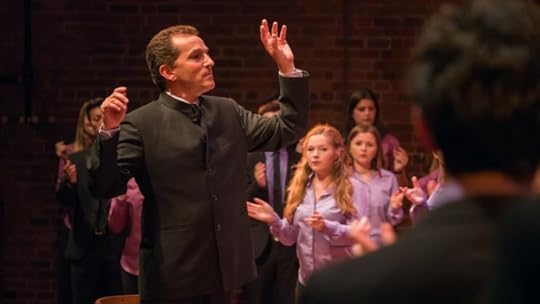 Ben Parry conducting in action. Used with permission.
Ben Parry conducting in action. Used with permission.The groups that you conduct range from amateur to professional choirs. Do your rehearsal and performance expectations differ between these?
One of the most satisfying things about conducting a range of choirs with differing abilities is how each approach informs the other. I expect the same enthusiasm, application, discipline, and attention to detail from whatever choir I’m working with. You’d expect that London Voices would deliver the goods almost without thinking about it, and that the commitment and enthusiasm of a choir like the National Youth Choir would be greater. However, sometimes it’s the other way round! It’s true to say that the more I put into a rehearsal or performance, the more I and the singers get out of it.
What do you look for when you’re recruiting new singers for the choirs you direct?
For younger choirs (National Youth Choir and Eton Choral Courses) you’re always looking for passion and potential, whereas London Voices relies on professional experience and reputation. With King’s Voices and Aldeburgh Voices, a shared love of singing is very important. But all singers should really share all of these qualities. I’d hate it if any of the singers I worked with weren’t happy singing. What I love is that sometimes the learning curve of a young singer on an Eton Choral Course is so much greater than the satisfaction of a job well done by one of the professionals.
What advice would you give to someone preparing for an audition to become a choir director?
It’s important to build up a good reputation through your work so people respect you and are confident in your abilities. I was offered co-direction of London Voices because Terry Edwards (founder and co-director) had heard I was good at running choirs. Stepping into someone else’s shoes can be hard, but it’s important to remain genuine.
Do you have any advice to offer to directors who are trying to set up their own choir?
The choral market is niche and definitely saturated with myriad choirs, so you need to be able to offer something unique and innovative – don’t just set up a choir because you want to. Ask yourself what the need is; it may be that you’d like to explore some undiscovered repertoire, or that the region you’re in doesn’t offer enough opportunities for keen singers. The journey through a music career can throw many challenges along the way, and isn’t always easy. But, if one does a good job, is enthusiastic, efficient, and polite you’ll go far and have a rewarding time!
Featured image credit: music notes sheet music bookeh and folder by David Beale. Public domain via Unsplash.
The post From singer to choir director: A Q&A with Ben Parry appeared first on OUPblog.

August 10, 2017
“My latest brain child”
In his 1954 essay ‘Metapsychological and Clinical Aspects of Regression within the Psycho-Analytical Set’, Donald Winnicott states:
“The idea of psycho-analysis as an art must gradually give way to a study of environmental adaptation relative to patients’ regressions. […] I know from experience that some will say: all this leads to a theory of development which ignores the early stages of the development of the individual, which ascribes early development to environmental factors. This is quite untrue. In the early development of the human being the environment that behaves well enough (that makes good-enough active adaptation) enables personal growth to take place.”
In a 1965 essay written for the British Psychoanalytical Society, ‘The Psychology of Madness: A Contribution from Psycho-Analysis’, he wrote:
“The practice of psycho-analysis for thirty-five years cannot but leave its mark. For me there have come about changes in my theoretical formulation, and these I have tried to state as they consolidated themselves in my mind. Often what I have discovered had been already discovered and even better stated […] This does not deter me from continuing to write down what is my latest brain-child.”
These words convey Winnicott’s most significant legacy to psychoanalysis: the theory of the mind of the Subject in constant evolution in its contact with the Other, along the pathway of life. This intuition has found important confirmations in the elements that have emerged from the research studies on the baby’s early stages of life, as well as from the explorations on the psychoanalytical treatment of borderline states and psychoses, and also regarding the approach to traumatic situations.
“Often what I have discovered had been already discovered and even better stated..”
Winnicott’s view of psychoanalysis aims to individuate the contexts – in terms of environment and treatment – in which the subject’s psychic life recovers and organizes itself according to new ways of functioning. He shows its plasticity, its potential for constant reorganization, and the presence of a way of functioning which is developmentally non-linear but experientially transformative in any stage of life.
Winnicott was aware that the development of psychoanalytic theory would greatly benefit from his clinical insights on the early stages of life of the mother-infant couple, and from the analysis of borderline patients. He was not indifferent to theory; on the contrary, he was curious and constantly researching. This biological and relational foundation of the development of the human being constitutes the fertilizing and founding core of his thought, which was received in Italy particularly by Eugenio and Renata Gaddini, to whom we must acknowledge the extraordinary merit of having grasped it and made it known.
Just because of this intrinsically biological and relational foundation, in relation to the well-known events linked to the Controversial Discussions in the British Psychoanalytical Society, Winnicott tried not to get stuck in a static and abstract ideological position, and he abstained from providing his theoretical-clinical findings with a coherent and complete theoretical structure. This is what others called “Winnicott’s illness,” as he himself remembered, with a certain ironical awareness, in a letter to Melanie Klein in 1952, in which he declines the offer to write a paper which should have been included in a book edited by her.
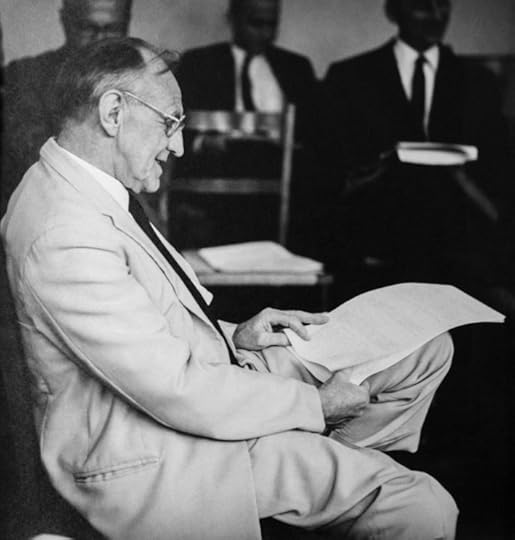 Winnicott presenting ‘A Psychotherapeutic Interview in Child Psychiatry’ at a Pre-Congress Clinical Seminar of the twenty-third Congress of the International Psychoanalytical Association, held in Stockholm on 24 July 1963.
Winnicott presenting ‘A Psychotherapeutic Interview in Child Psychiatry’ at a Pre-Congress Clinical Seminar of the twenty-third Congress of the International Psychoanalytical Association, held in Stockholm on 24 July 1963.Courtesy of Barbara Young, held in Donald Woods Winnicott Archive, in the care of the Wellcome Library.
However, in 1971, the very year of his demise, Winnicott decided to publish a book, Playing and Reality, which comprises in an organic – albeit not organized – manner, his papers on the theory relative to his most significant psychoanalytical discovery; the individuation of the transitional area in the psychic functioning of the human subject.
The conceptual developments of Winnicott’s thought were not organized by him in a coherent and complete scheme; they were scattered as discrete elements which fertilized several fields and different theories. As is the case with every particularly creative thinker, a later, inevitable reductionist phenomenon took shape. The founding formula: “there is no such thing as a baby, there is a baby and someone”, was impoverished and reduced to a scheme that gave mechanical, excessive importance to the environment, obscuring the primary creativity of the infant.
However, the absence of a coherent and complete framework in Winnicott’s thought may also be read in another way, as the expression of his determined will not to renounce the polarity between biology and narration. A polarity which is intrinsic to Freud’s way of thinking, who had characterized its origin without reaching a unitary resolution; Winnicott confirmed and amplified such polarity, driving this tension forward.
In his Project for a Scientific Psychology, Freud’s intention was to develop psychology as a natural science which might express itself in terms of forces and structures, according to the language of the sciences of his time. But in Studies on Hysteria, written in the same period, the exposition of his clinical cases takes the form of a necessary narration, intrinsic to the theory from which they originated. Such polarity travels through the entire history of psychoanalysis.
Similarly, Winnicott did not intend to disarticulate his theory on psychic functioning from what he indicated as the psyche-soma, the sensory experience from which the mind takes its shape. At the same time, giving theoretical consistency to the area of transitional phenomena, and to the production of that intermediate world to which the analytic process also belongs, Winnicott confers to this third reality the status of a psychic structure that is fundamental for mental functioning.
Psychoanalytical productions, as well as artistic ones, utilize concrete, sensory elements which have a life of their own outside the subject, but which the subject recreates by conferring a personal meaning upon them. They do not belong to the field of hermeneutics, of descriptions and explanations as external captions for the subject’s psychic life.
Therefore, Winnicott maintains the implicit tension of Freudian thought between biological dynamics and narrative construction; he does not resign himself to formulate an organic theory that for the sake of completeness should renounce either experience or dreams as they emerge from the psyche-soma. Winnicott stays with this tension, convinced as he is that research studies, both in the biological field and in the relational field of the analytic situation, will yield further interesting results.
Featured image credit: Child by geralt. CC0 Public domain via Pixabay.
The post “My latest brain child” appeared first on OUPblog.

Culture, inequalities, and social inclusion across the globe: a ASA 2017 reading list
This year, the 2017 American Sociological Association Annual Meeting takes place in Montreal, and our Sociology team is gearing up. The 112th Annual Meeting will take place from 12- 15 August, bringing together over 5,000 sociologists nationwide for four days of lectures, sessions, and networking with some of the top figures in the field.
This year’s theme is “Culture, Inequalities, and Social Inclusion across the Globe.” The annual meeting is focusing on improving our understanding of the nexus of culture, inequalities, and group boundaries, in order to promote greater social inclusion and resilience, collective well-being, and solidarity throughout the world.
The conference schedule has a variety of meetings, workshops, and sessions to check out. Ahead of the conference, we have created a reading list of authors attending ASA17 to discuss important topics and issues within the field, and to raise awareness of current inequalities and promote social inclusions across the world.
Citizen Protectors: The Everyday Politics of Guns in an Age of Decline by Jennifer Carlson
A Gallup poll conducted just a month after the Newtown school shootings found that 74% of Americans oppose a ban on hand-guns, and at least 11 million people now have licenses to carry concealed weapons as part of their everyday lives. Why do so many Americans not only own guns but also carry them? In Citizen-Protectors, Jennifer Carlson offers a compelling portrait of gun carriers, shedding light on Americans’ complex relationship with guns.
Denial of Violence: Ottoman Past, Turkish Present, and Collective Violence against the Armenians, 1789-2009 by Fatma Muge Gocek
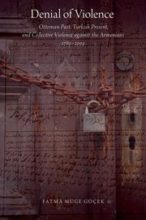
Winner of the 2015 Mary Douglas Prize for Best Book, Sociology of Culture Section, American Sociological Association, and 2016 Barrington Moore Book Award, Honorable Mention, Comparative Historical Sociology Section of the American Sociological Association.
Denial of Violence develops a novel theoretical, historical, and methodological framework to understanding what happened and why the denial of collective violence against Armenians still persists within Turkish state and society.
National Colors: Racial Classification and the State in Latin America 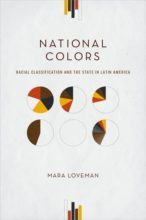 by Mara Loveman
by Mara Loveman
Winner of the 2015 Best Scholarly Book Award from the American Sociological Association Section on Global and Transnational Sociology , and 2015 Oliver Cromwell Cox Book Award from the American Sociological Association Section on Racial and Ethnic Minorities.
Mara Loveman explains why most Latin American states classified their citizens by race on early national censuses, why they stopped the practice of official racial classification around mid-twentieth century, and why they reintroduced ethnoracial classification on national censuses at the dawn of the twenty-first century. The way census officials described populations in official statistics, in turn, shaped how policymakers viewed national populations and informed their prescriptions for national development—with consequences that still reverberate in contemporary political struggles for recognition, rights, and redress for ethnoracially marginalized populations in today’s Latin America.
Despite the Best Intentions: How Racial Inequality Thrives in Good Schools by Amanda E. Lewis and John B. Diamond
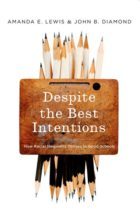
Through five years’ worth of interviews and data-gathering at Riverview high school, John Diamond and Amanda Lewis have created a rich and disturbing portrait of the achievement gap that persists more than fifty years after the formal dismantling of segregation. As students progress from elementary school to middle school to high school, their level of academic achievement increasingly tracks along racial lines, with white and Asian students maintaining higher GPAs and standardized testing scores, taking more advanced classes, and attaining better college admission results than their black and Latino counterparts. Most research to date has focused on the role of poverty, family stability, and other external influences in explaining poor performance at school, especially in urban contexts.
The Tumbleweed Society: Working and Caring in an Age of Insecurity by Allison Pugh
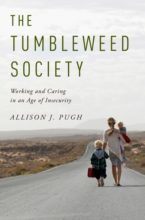
Today we live in a society in which relationships, social ties, and jobs seem to change constantly. People roll this way and that, like tumbleweeds blown across an arid plain. How do we raise children, put down roots in our communities, and live up to our promises at a time when flexibility and job insecurity reign? Allison Pugh offers a moving exploration of sacrifice, betrayal, defiance, and resignation, as people adapt to insecurity with their own negotiations of commitment on the job and in intimate life.
Wounded City: Violent Turf Wars in a Chicago Barrio by Robert Vargas

Winner of the 2017 Distinguished Book Award from the Political Sociology Section of the American Sociological Association and 2016 Outstanding Book Award, Section on Peace, War and Social Conflict, American Sociological Association.
Wounded City dispells the popular belief that a lack of community is the primary source of violence, arguing that competition for political power and state resources often undermine efforts to reduce gang violence. Robert Vargas argues that the state, through the way it governs, can contribute to distrust and division among community members, thereby undermining social cohesion.
Soybeans and Power: Genetically Modified Crops, Environmental Politics, and Social Movements in Argentina by Pablo Lapegna
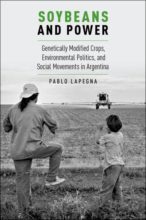
Winner of the 2017 Best Book Award, Sociology of Development Section of the American Sociological Association.
Although Argentina’s use of genetically modified (GM) soybean seeds has spurred a major agricultural boom, it has also had a negative impact on many communities, including deforestation of native forests, prompted the eviction of indigenous and peasant families, and spurred episodes of contamination. Soybeans and Power investigates the ways in which rural populations have coped with GM soybean expansion in Argentina. It also gives voice to the communities most adversely affected by GM technology, as well as the strategies that they have enacted in order to survive.
Have questions for us? We’ll be at booths 915-919 in the exhibit hall with our latest books, journals, and online resources in sociology. The ASA Exhibit Hall will be located in Hall 220C in the Palais des Congrès de Montréal.
Stop by between the following hours:
Saturday, 12 August 2:00 – 6:00 p.m.
Sunday, 13 August 9:00 a.m. – 4:00 p.m.
Monday, 14 August 9:00 a.m. – 5:00 p.m.
Tuesday, 15 August 9:00 a.m. – 1:00 p.m.
We hope to see you in Montreal!
Featured image credit: Montreal City night by Free-Photos. Public domain via Pixabay.
The post Culture, inequalities, and social inclusion across the globe: a ASA 2017 reading list appeared first on OUPblog.

Introducing Hannah, OUP’s Music Hire Librarian
We are delighted to introduce Hannah Boron, who joined OUP’s Music Hire Library team in March 2017 and is based in the Oxford offices. We asked her to tell us what her job involves and chatted more generally about fantasy novels and how she would like to be Lara Croft.
What does a sheet music hire librarian actually do?
Some people are surprised, when I tell them what I do, that music publishers hire music to customers as well as sell it. Not all OUP music is available to buy. For large orchestral works like symphonies and concertos, for example, it often wouldn’t be cost-effective to print sets of parts to sell via music shops–but the music still needs to be available for people to access and perform.
That’s where the Hire Library comes in. We keep sets of orchestral parts (and sometimes vocal scores too) for a huge variety of works from composers as far back as Purcell and Monteverdi to those who are active now, like Bob Chilcott and Zhou Long. When a performing group wants to play an OUP work, they get in touch with us and arrange to borrow the parts they need for however long it will take them to rehearse and perform the piece, in exchange for a hire fee.
Some of the repertoire we hire out is also available for sale, which gives customers options, but if a performing group is only expecting to use the music once, they often feel it is better to hire than buy. Our customers range from small amateur ensembles to some of the UK’s top orchestras!
When did you start working at OUP?
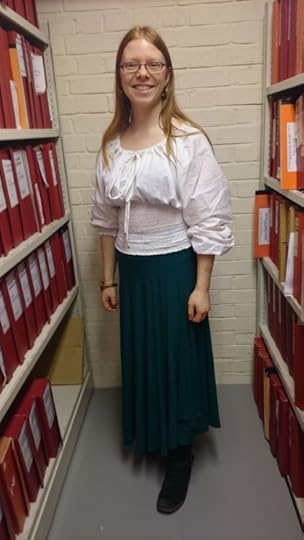 Hannah Boron
Hannah BoronAt the end of March 2017, so very recently in relative terms! Somehow it feels as though it has been both shorter and longer than that, possibly because it’s such a friendly environment.
What is your typical day like at OUP?
I walk to work, which takes about forty minutes, and usually sets me up well for the day. The first thing I do, once I’m settled at my desk, is look in the email inbox and sort out the quote requests from the orders that can be booked immediately–and see if there’s anything urgent!
Then it’s time to assemble the orders that are due to be dispatched. The first batch of the day’s post is collected at 11am, after which I’m usually ready for a cup of tea! Depending on how many emails there are to reply to, it’s always good to spend some time booking returned music back into stock. There are often missing pieces of material to be chased up with customers too.
What are you reading right now?
I am a huge fan of Terry Pratchett’s Discworld books, and am currently reading The Shepherd’s Crown. The last thing I read was Angela Carter’s Nights at the Circus, which is an opulently fantastical book: her use of language is truly virtuosic.
If you didn’t work in publishing, what would you be doing?
I would want to be either a writer or a singer. I have completed and published one fantasy adventure novel, involving a bounty hunt for thief gangs set in a pseudo-Middle Eastern landscape, and am working on another one.
I have sung in various different choirs over the years but am currently concentrating on my solo repertoire, mainly in the musical theatre genre. My recent performance of “Whatever Happened to my Part?” (from Spamalot) at the Abingdon Music Festival went down so well that I made it into the final concert! I’m quite quiet a lot of the time, so people are often surprised when they hear me sing. Apparently I have an inner diva…
If you could trade places with any one person for a week, who would it be and why?
I don’t think of myself as a particularly hardy person, so I would like to have the experience of being someone who is physically adventurous. Being Lara Croft would be awesome!
If you were stranded on a desert island, which three items would you take with you?
An endless supply of pens and paper, my keyboard (assuming there was a power source somewhere)–and a complete set of Discworld novels.
Featured image: Hire Library shelves by Elanor Caunt. Copyright Oxford University Press.
The post Introducing Hannah, OUP’s Music Hire Librarian appeared first on OUPblog.

August 9, 2017
In memoriam: Professor Alan Cameron
On 31 July, one of the most eminent Classical scholars of our time, the esteemed OUP author Alan Cameron, passed away. My colleagues at the press and I extend our sincere condolences to his wife Carla and his surviving family. In a career that spanned several decades, Alan published so many critically important articles and books, on such a diverse group of subjects—from the literature of the Hellenistic age to Late Antiquity—that one would be hard pressed to isolate any one of these works as representative of the man and the scholar. And yet, I will always associate the name of Alan Cameron with his formidable The Last Pagans of Rome, which I had the great fortune to publish in 2011. This book was truly formidable in every way: its sheer size was capable of stopping a vault door; its learning, amassed over a lifetime of scholarship, was graphically represented in a nearly 50-page (large trim, small font) bibliography. The book took aim, to devastating effect, at the persistent myths about the end of paganism in the West—devastating, yes, but not without Alan’s characteristic sense of humor, which was always on display whenever I had the chance to visit him in Morningside Heights. More surely will be written about Rome in the fourth and fifth centuries CE, but nothing will appear in that area without first taking into account The Last Pagans of Rome. This could be said about so many other subjects that attracted his attention and his pen, and it doubtless will be said for very many years to come.
For more information about Alan’s distinguished career, see the notice posted by the Department of Classics, Columbia University.
Featured image credit: “looking downtown” by Ilahbocaj, CC BY 2.0 via Flickr.
The post In memoriam: Professor Alan Cameron appeared first on OUPblog.

Bodily identity and biotypology in Brazil
What does your body shape say about you? When typing this question on any online search engine one will find dozens of examples and images of models of varying bodily classifications as well as the relationship of bodily shape with many different types of physical and mental health and even personality. Rectangle, triangle, round, hourglass, slender, pear, apple, etc, are widespread categories used to label the body according to the culture of health, nutrition, fitness, bodybuilding and even in the clothing industry for women. Nowadays these representations pervade the popular media and provide easier information on patterns of aesthetics and normality used in the self-classification of people’s body. However, what most people do not know is that these categorizations for clustering human biological variation in identifiable body types and shapes have been commonplace since the mid-twentieth-century and were historically rooted in a science called “biotypology” or “constitutional medicine”.
The classificatory lexicon of biotypology entered medical and scientific practices across the world between the 1920s and 1930s, initially providing a holistic view of the patients, and included an interpretation of people morphology, physiology, and character. Biotypologists were linked to the Western interest in accurately measuring and categorizing human biological diversity, but, at the same time, were skeptical on reductionist approaches to organism and strict racial taxonomies applied to human groups worldwide. The scientific agenda of biotypology, for its part, involved complex modalities of labelling and distinguishing between healthy and sick or normal and deviant people by their bodily form. Classification of people was thus determined by the harmony, predominance, or deficiency in proportion to the body segments. The most common and diffused categories were long types, short (branchy) types, and normal types. This science also had evident social implications, and was even considered an instrument to determine nations’ bodily identities and solve local bio-political problems, such as in Argentina or Italy, where this reasoning informed medical approaches and policies to women.
Biotypology can be thus considered as a facet or even a modified version of eugenics, overlapping eugenics theoretical debates on the influence of heredity and/or environment factors on the population, but, in its practice, is more focused on the health care of the individual rather than on techniques of population management. Its scientific and intellectual origins are found in fascist Italy, where fascist doctors like Nicola Pende developed methods of classification to identify the national bodily identity, connected to a wider biopolitical agenda on the medical and scientific control and betterment of the nation through public health policies on reproduction, motherhood, and childcare, for instance. The ideals, theories and practices of biotypology soon gained prominence in Latin countries such as Portugal, Spain, France, Argentina, Mexico, and Brazil, where local scientific elites and intellectuals were seeking to define the eugenic character of their nations. In Latin America, for instance, doctors set out several research projects to classify local populations by applying taxonomies from the Italian models in search for a universal “normotype”. Constitutional medicine established secure academic niches in Brazil, the most important one at the School of Medicine of Rio de Janeiro, where there was a cabinet for biotypological investigations and whose doctors published the most important texts and studies on the theme in Brazil. It was also considered scientific content in criminology, forensic medicine, physical education, public education, and the army.
“Biotypology developed in Brazilian medical culture in the 1920s and 1930s amid debates on ‘national identity’”
However, in Brazil, biotypology never reached an institutional standing such as in Argentina, where its scientific activities were consolidated in the Argentina Association for Biotypology, Eugenics, and Social Medicine and consequently received wide academic support. Also, there is no evidence it had become an autonomous scientific field in Brazil or was effectively employed as an instrument in public health issues. Nonetheless, several doctors and social scientists in Brazil enthusiastically adhere to biotypological frameworks and employed Italian categories and practices of bodily normalization in the Brazilian population. Biotypology developed in Brazilian medical culture in the 1920s and 1930s amid debates on ‘national identity’ based on its supposed intrinsic ethnic, social, and cultural characteristics. It had therefore clear social applications. Biotypological taxonomy was mainly related to racialist categorizations and was initially viewed as useful for defining a ‘normal’ Brazilian body type, such as in the study “The Brazilian Normotype” or the regional study “The morphology of Northeast man—a biotypological study”, both carried out during the 1930s. But their pursuing of a pattern of bodily normality to the Brazilians failed. There was no single Brazilian body type; rather, Brazil was a country composed of various shapes and sizes, scientists concluded. In light of the heterogeneity of the bodily forms of the population, practitioners in Brazil creatively adapted foreign models of biotypology and even created their own methods and labelling for determining the supposedly normal bodies. An evident effort was made to legitimate biotypology and its new lexicon as an alternative medical field that could contribute to contemporary racial and sociological debates and political projects on national identity in Brazil in the 1930s. Brazilian biotypologists presented a composite discourse strategy on race connected to an ideal of bodily normality, refuting and applying old and new racialist reasoning in their studies. Biotypological studies in Brazil corroborated the bodily heterogeneity and diversity of Brazilians, contributing to a positive contemporary view of miscegenation and, therefore, the perspective of a national bodily identity in the plural.
Featured image credit: Female body type by Arne Hendricks. CC BY 2.0 via Flickr.
The post Bodily identity and biotypology in Brazil appeared first on OUPblog.

Our shortest words continued: “of,” “both,” and (again) “if”
Last week, we looked at the history of the conjunction if, and it turned out that the Dutch for if is of. The fateful question asked “at dawn,” when “Scheherazade” had to stop her tale, was: “Are English if and of related?”
 Scheherazade at her best.
Scheherazade at her best.Unfortunately (or fortunately), the existence of family ties between if and of cannot be posited, because Engl. of is an impostor: it emerged as an unstressed variant of æf (the letter æ, called in Old English studies “ash,” had the value of a in Modern Engl. am). The historically true form can be seen only in the prefix æf. For instance, Old Engl. æfgrynde “abyss” is the exact analog of Modern German Abgrund (the same meaning), that is, “off (the) ground.” The German word shows that the form of our preposition had an a-like vowel, and indeed, æ is what we have found.
Engl. of, though a newcomer, felt quite comfortable in its new home and behaved like all social climbers: it ousted its “parent” æf and developed an emphatic form, namely off, which today can function even as a prefix (offhand, offshore). Although the tautological preposition off of surfaced in texts as early as the second half of the sixteenth century, it seems that its recent home has been the American continent. Jack London’s characters use off of all the time, while Dickens and Thackeray (both great lovers of slang and substandard English) hardly ever heard it. Of also sneaks in where no one needs it, as in outside of and alongside of. Conversely, it has been reduced to o’ in o’clock, tam o’ shanter, and the like. One cannot win all the time. Anyway, one tiny trace of af ~ æf may still be visible. The origin of Engl. after (with related forms elsewhere in Germanic) has not been settled; it may be æf– with a suffix of the comparative degree. Gothic also had af–tuma “last,” and, unexpectedly, if-tuma “next, following,” with the variation a ~ i in the root (the product of the chaos whose politically correct name is ablaut).
The cognates of æf are not far to seek. Gothic, Old Icelandic, and Old Saxon had af; in Old High German aba, the last sound reminds us of ó in Greek apó– “away from.” English speakers know the Greek prefix from numerous borrowings, such as apostrophe, apotheosis, and so forth. In Germanic, stress was shifted, as always, to the first syllable, so that, not unexpectedly, the second vowel fell off, but in Slavic it remained where we find it in the protoform. Therefore, in that language group, the word’s first vowel was lost, which resulted in the appearance of the preposition and prefix po (for instance, po-russki “in Russian”); its Lithuanian congener is pa. Without some knowledge of historical linguistics it is hard to believe that German ab and Russian po are exact cognates.
I’ll leave it to serious students to explain why Greek has apó-, while German had ab (pay attention to the place of stress in Greek!), but those who know Swedish, Norwegian, or Danish will remember the preposition på “on.” It goes back to what was upp á “up on; upon” in Old Norse. The vowel á, that is, ā (long a), became long o in the continental Scandinavian languages. In upp á, stress fell on the second syllable. Therefore, the first syllable was lost, and, as a result, we have the modern form på. The process resembles the one described above for Slavic po. Woe to unstressed vowels!
Naturally, we still don’t know why the sound complex apó– or its ancestor meant “away from”; we hardly ever manage to reach such depths. (However, see the end of this post!). Since I have nothing else to say about the etymology of the preposition of, I will return to my previous post. In it, the Gothic word ibai “whether,” a cognate of Engl. if, was mentioned and presented as the compound i-bai. Bai, I stated, is either a particle or a word meaning “both.” Assuming that it means “both” (the more likely assumption), we obtain an elegant etymology of the conjunction if.
Engl. both in the form in which we today know it was borrowed from Scandinavian and consists of bo + th. Gothic had bai in the masculine and ba in the neuter. Old Icelandic báðir (read ð as th in Engl. the) consisted of bá– and a pronoun meaning “they” (thus, “both of them”). In Engl. both, –th is the stub of that old pronoun. If Gothic ibai really consisted of the pronominal root i-, glorified in the previous post, and a word for “both,” we begin to understand why it meant “whether”: the root pointed to a certain object, whereas “both” indicated the possibility of choosing between two options (both alternatives were possible!). Hence “whether,” “if,” doubt, hesitation, stipulation, and the rest mentioned a week ago.
The result is so inspiring that an additional comment on both may be justified. Gothic bai has a regular plural ending of an adjective, but, judging by its Sanskrit cognate u-bhāú, –ai was an innovation. The oldest Indo-European pronouns for the first and the second person had three numbers: singular, dual, and plural. The dual was used for “we two” and “you two.” Verbs, when they followed such pronouns, had corresponding endings. Almost nothing is left of the dual in Modern Germanic, but Engl. we is a relic of the plural, while Icelandic vit “we” continues the dual (originally we two). The ancient ending of the dual was –au. Of course, the word for “both” had to be dual! The choice suggested by it must have been between two objects, and whether referred to a similar binary choice, something like either—or. This is the true beginning of if. To be sure, if is only what remains of the old form, but Gothic ibai shows how the history of that conjunction started. Incidentally, our alternating conjunctions were at one time and…and, or…or, not both…and and either…or.
 Eight: The dual ideal
Eight: The dual idealSince I found myself dealing with the dual and, considering the important fact that the posts for 12 July and 19 July 2017 were devoted to the numerals six and hundred respectively, I would like to dwell on the subject of the dual for some more time. The Gothic for “eight” was ahtau, an obvious cognate of Greek októ, with the ending preserved better in Gothic than in Classical Greek. This ending suggests that eight was some kind of dual. But what was doubled? If it is true that at the beginning of civilization, fingers served as one of the tools for counting, we have in eight “twice four.” Two open palms, disregarding the thumbs? Perhaps so, but who can tell! It is no wonder that the etymology of eight remains a hotly debated question. Isn’t ten “twice five”? The Latin for “ten” was decem, and de– does make us think of “two” (compare Latin duo), but two of what? Two hands? Two units of some sort? In any case, ten is not a dual (though it could have been such!), and eight, most probably, is. Also both was once upon a time a dual, which leaves us, like the famed Buridan’s ass, facing a difficult choice: what if?
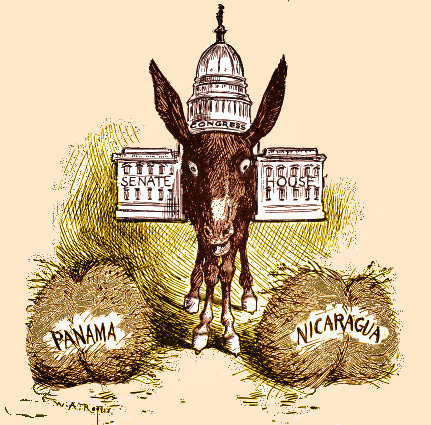 What if?
What if?And now my last tale of this cycle is told, and the story teller is pardoned by the mollified sultan. The next post will broach an entirely different subject.
Image credits: (2) “Hands” by Erik F. Brandsborg, CC BY-SA 2.0 via Flickr (3) “Deliberations of Congress” Public Domain via Wikimedia Commons. Featured image credit and (1): “Sheherazade and Sultan Schariar” by Ferdinand Keller, Public Domain via Wikimedia Commons.
The post Our shortest words continued: “of,” “both,” and (again) “if” appeared first on OUPblog.

The mysterious painting methods of Vermeer
Johannes Vermeer’s luminous paintings are loved and admired around the world, yet it is not fully understood exactly what painting methods he used. Experts over the years have been confounded as to how he captured light in such a way as to create a sense of a moment in time captured on canvas. Why is there an absence of any preliminary drawing; why are there shifts in focus, why did he appear to use large amounts of expensive pigments? The image below discusses seven of his masterpieces, and reveals the few traces Vermeer has left behind in an intriguing detective story.

Featured image credit: The Girl with a Pearl Earring by Johannes Vermeer (1632–1675). Public domain via Wikimedia Commons.
The post The mysterious painting methods of Vermeer appeared first on OUPblog.

10 facts about the Mormon religion
Especially to those outside the faith, the beliefs and practices of the Mormon religion are largely unknown, and this has led to caricatures of the Church of Jesus Christ of Latter-day Saints. Below are 10 facts about Mormonism taken from Feeding the Flock: The Foundations of Mormon Thought: Church and Praxis by Terryl L. Givens.
1. In Mormon theology, the purpose and project of man is not to glorify or to serve God, but rather the inverse. It is God’s project and purpose to create the conditions for human happiness, by Him bringing to pass the immortality and eternal life of man. Instead of an angry or demanding Father, Mormons see Him as loving and devoted to His progeny.
2. Additionally, God’s purpose is not to reverse the sin, corruption, and death introduced into human existence by Adam. The Fall of Adam was only one part of God’s plan and not its major pivot point. God is less of a doctor whose job it is to heal a sick patient, but rather a physical trainer who works with an already healthy person to help him or her become more physically fit.
3. While community is undoubtedly important in other Christian denominations, in Mormonism it is an element of salvation itself. Community tends to be a way to bolster the morale and the prospects of salvation of each individual member by worshipping together and working against loneliness and individual alienation. Mormons construe salvation as bringing oneself into a web of eternal relations with other human beings as well as with God, what Joseph Smith referred to as a “sociality” with friends and family “coupled with glory.”
 The Book of Mormon, Another Testament of Jesus Christ. Published by The Church of Jesus Christ of Latter-day Saints, August 2009 by 101heather. Public domain via Wikimedia Commons.
The Book of Mormon, Another Testament of Jesus Christ. Published by The Church of Jesus Christ of Latter-day Saints, August 2009 by 101heather. Public domain via Wikimedia Commons.4. Mormonism traces its roots to a theophany (a manifestation or appearance of God or a god to a man) experienced by the founder of the faith, Joseph Smith, in a grove of trees in upstate New York when Smith was just 14 years old in 1820. Although this was Smith’s first experience of this type, he didn’t immediately take up his later role as religion-maker, even commenting a year or so later that he was “not so much a christian [sic] as many suppose I am.”
5. A second vision or theophany was the true initiation of the Mormon faith, some three years after Smith’s first encounter. Smith claimed that the angel Moroni appeared to him and laid the foundation for what would become the Book of Mormon, and to which Smith himself dates the foundation of the Church of Jesus Christ of Latter-day Saints.
6. The Book of Mormon was published seven years after Moroni’s first visitation and entered into circulation in March 1830. Smith claimed that the Book of Mormon detailed the new covenant between God and the House of Israel, encompassing and yet expanding upon the “old” covenant of Judaism and the “new” covenant of Christianity. The Book of Mormon itself is a scriptural synthesis of the “old” and “new” covenants, drawing upon both the Old and the New Testament in its narrative.
7. In Mormonism, there is the belief that actual descendants of the ancient House of Israel from Jerusalem made their way to America under the leadership of Lehi. Thus Native Americans are included in the covenant, although ‘they are in need of evangelization by a “great Gentile nation”’ (Smith and those of white European descent).
8. Mormonism maintains that without the sacraments of the church, salvation is impossible. At the same time, its conception of evangelization of the dead means that “Mormonism” is the name of an institution whose reach is universal and timeless. Thus for Mormons, the Church both refers to the historical institution established in 1830 and simultaneously the body of the faithful, living and dead, who at any time now or in the eons of time to come, receive the ordinances of salvation and abide their corresponding covenants. In other words, the physical church is how one becomes integrated into eternal relationship with a heavenly family (the spiritual church), and while it is the only way to salvation, it is also simultaneously open to anyone, living or dead.
9. The social dimension of Mormonism is encapsulated in the idea of Zion. Zion is both the process and the goal of creating heaven on this earth, in the here and now. Crucially, Zion-building is not simply preparation for heaven, but actually heaven itself, in embryo, a mirror of eternal and transcendent heaven.
10. Initial branches of the church were established in Colesville and Palmyra, New York, and Harmony, Pennsylvania, then moving westwards to Kirtland, Ohio, and then further to sites in Missouri. Conflict followed the Mormons, culminating in the killing of Smith himself in 1844 in Nauvoo, Illinois. Eventually the Mormons moved to modern day Utah. At the time of Brigham Young’s death in 1877, he governed a cultural region larger than Texas and a church that comprised in excess of 100,000 Mormons.
Featured image credit: Salt Lake Temple as seen from S Main Street in Salt Lake City, Utah, USA by Hermann Luyken. Public domain via Wikimedia Commons.
The post 10 facts about the Mormon religion appeared first on OUPblog.

August 8, 2017
The life and work of Angela Carter [timeline]
Award-winning author Angela Carter is widely viewed as one of the great modern English writers. Known for her use of magic realism and picaresque prose, Carter’s writing style reflected the world around her, capturing 1960s counterculture and second wave feminism.
The timeline below, created from The Invention of Angela Carter: A Biography, highlights key moments from Carter’s life and career, from her personal life, to her monumental time spent living in Hong Kong, to her professional achievements. Carter’s lead a life filled with intensity and turmoil, all the while pioneering literary genres and becoming a feminist icon.
Featured image provided by the estate of Angela Carter. Please do not re-use without permission.
The post The life and work of Angela Carter [timeline] appeared first on OUPblog.

Oxford University Press's Blog
- Oxford University Press's profile
- 237 followers



